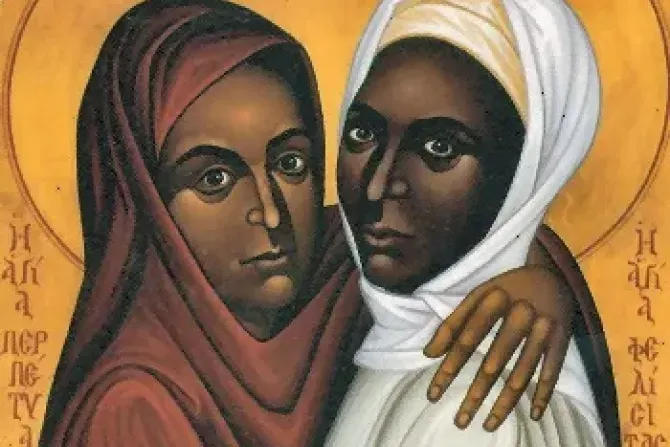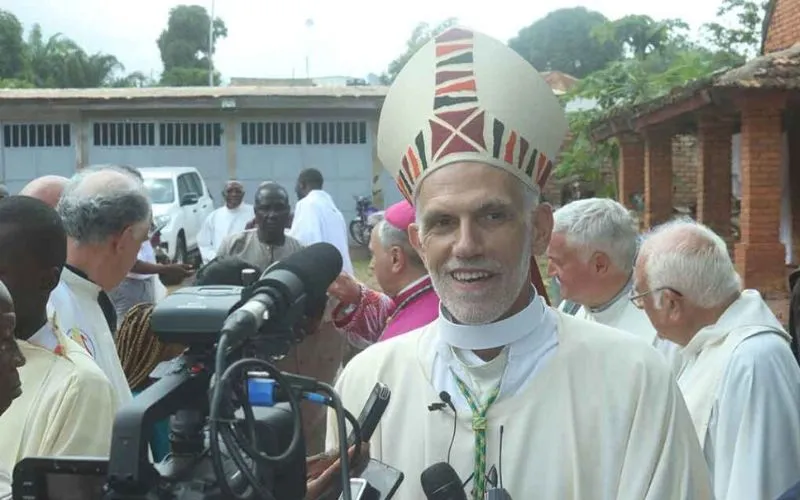Apparently, he was the only member of her family who did not share the Christian faith. He made repeated attempts to get her to renounce the faith, and he suffered greatly at the thought his daughter would be killed by the authorities. Perpetua was deeply moved to see how much he was suffering because of his love for her.
He comes to her repeatedly throughout the text, trying to find a way to save her life. He doesn’t realize what it would mean for her to abandon the faith, but you can’t help feeling for his persistence, inventiveness, and raw desperation in trying to find a way to save his daughter’s life.
On one occasion, this happened:
“And then my father came to me from the city, worn out with anxiety. He came up to me, that he might cast me down [from my profession of faith], saying,
“‘Have pity my daughter, on my grey hairs. Have pity on your father, if I am worthy to be called a father by you. If with these hands I have brought you up to this flower of your age, if I have preferred you to all your brothers, do not deliver me up to the scorn of men. Have regard to your brothers, have regard to your mother and your aunt, have regard to your son, who will not be able to live after you. ...’
(Story continues below)
“These things said my father in his affection, kissing my hands, and throwing himself at my feet; and with tears he called me not Daughter, but Lady.
“And I grieved over the grey hairs of my father, that he alone of all my family would not rejoice over my passion.
“And I comforted him, saying, ‘On that scaffold whatever God wills shall happen. For know that we are not placed in our own power, but in that of God.’ And he departed from me in sorrow.”
On another occasion, he tried to get her to renounce the faith using an appeal to her infant son:
“Another day, while we were at dinner, we were suddenly taken away to be heard [by the judicial authorities], and we arrived at the town-hall.
“At once the rumour spread through the neighbourhood of the public place, and an immense number of people were gathered together. We mount the platform. The rest were interrogated, and confessed [the Christian faith].
“Then they came to me, and my father immediately appeared with my boy, and withdrew me from the step, and said in a supplicating tone, ‘Have pity on your babe.’”
The pagan authorities even beat Perpetua’s father with rods in front of her to try to get her to abandon the faith, but she wouldn't.
Ultimately, though, her father’s efforts fail. She stays true to what she told him at the beginning of his efforts:
“‘Father,’ said I, ‘do you see, let us say, this vessel lying here to be a little pitcher, or something else?’
“And he said, ‘I see it to be so.’
“And I replied to him, ‘Can it be called by any other name than what it is?’
“And he said, ‘No.’
“‘Neither can I call myself anything else than what I am, a Christian.’”
4. What visions does Perpetua receive?
Several visions are narrated in the text:
-
The first is a vision of a ladder, and it concerns Perpetua’s martyrdom and arrival in heaven.
-
She also has a pair of visions concerning her deceased brother, Dinocrates, who is trying to drink from a fountain.
-
In another vision, she fights the devil in the form of an Egyptian gladiator.
5. What happens in the vision of the ladder?
One vision concerns the fact that she will be martyred:
“Then my brother said to me, ‘My dear sister, you are already in a position of great dignity, and are such that you may ask for a vision, and that it may be made known to you whether this is to result in a passion [a martyrdom] or an escape.’”
She then receives the following vision:
“I saw a golden ladder of marvellous height, reaching up even to heaven, and very narrow, so that persons could only ascend it one by one; and on the sides of the ladder was fixed every kind of iron weapon. There were there swords, lances, hooks, daggers; so that if any one went up carelessly, or not looking upwards, he would be torn to pieces and his flesh would cleave to the iron weapons. And under the ladder itself was crouching a dragon of wonderful size, who lay in wait for those who ascended, and frightened them from the ascent.
“And [my companion] Saturus went up first, who had subsequently delivered himself up freely on our account, not having been present at the time that we were taken prisoners. And he attained the top of the ladder, and turned towards me, and said to me, ‘Perpetua, I am waiting for you; but be careful that the dragon does not bite you.’
“And I said, ‘In the name of the Lord Jesus Christ, he shall not hurt me.’ And from under the ladder itself, as if in fear of me, he slowly lifted up his head; and as I trod upon the first step, I trod upon his head.
“And I went up, and I saw an immense extent of garden, and in the midst of the garden a white-haired man sitting in the dress of a shepherd, of a large stature, milking sheep; and standing around were many thousand white-robed ones.
“And he raised his head, and looked upon me, and said to me, ‘You are welcome, daughter.’
“And he called me, and from the cheese as he was milking he gave me as it were a little cake, and I received it with folded hands; and I ate it, and all who stood around said ‘Amen.’
“And at the sound of their voices I was awakened, still tasting a sweetness which I cannot describe. And I immediately related this to my brother, and we understood that it was to be a passion, and we ceased henceforth to have any hope in this world.”
6. What happens in the visions of her little brother?
Perpetua relates the first as follows:
“I saw Dinocrates going out from a gloomy place, where also there were several others, and he was parched and very thirsty, with a filthy countenance and pallid colour, and the wound on his face which he had when he died.
“This Dinocrates had been my brother after the flesh, seven years of age who died miserably with disease — his face being so eaten out with cancer, that his death caused repugnance to all men.
“For him I had made my prayer, and between him and me there was a large interval, so that neither of us could approach to the other.
“And moreover, in the same place where Dinocrates was, there was a pool full of water, having its brink higher than was the stature of the boy; and Dinocrates raised himself up as if to drink. And I was grieved that, although that pool held water, still, on account of the height to its brink, he could not drink. And I was aroused, and knew that my brother was in suffering.”
Perpetua then begins to pray daily for him to ease his suffering, and she eventually receives the following vision:
“I saw that that place which I had formerly observed to be in gloom was now bright; and Dinocrates, with a clean body well clad, was finding refreshment.
“And where there had been a wound, I saw a scar; and that pool which I had before seen, I saw now with its margin lowered even to the boy’s navel.
“And one drew water from the pool incessantly, and upon its brink was a goblet filled with water; and Dinocrates drew near and began to drink from it, and the goblet did not fail.
“And when he was satisfied, he went away from the water to play joyously, after the manner of children, and I awoke.
“Then I understood that he was translated from the place of punishment.”
This pair of visions testify to the belief in the early Christian community of the value of praying for the departed and to what we would now refer to as purgatory.
7. Who was Felicity?
Perpetua is often mentioned together with one of her companions — Felicity — as is the case in Eucharistic Prayer I.
Felicity was another woman who was arrested at a time when she was eight months pregnant. She was eager to go to heaven, however, and did not want to be delayed by being martyred after her friends.
The fact that she was pregnant, however, might have interfered with this, since it was not lawful to put a pregnant woman to death.
She and her companions therefore prayed and, though she was not yet full term, she delivered her baby — a girl — who was given to a “sister” (a fellow Christian woman) to raise as her own daughter.
Felicity thus was able to be martyred with her friends.
8. How did Perpetua and Felicity die?
Perpetua and her companions were martyred by being subjected to wild beasts.
The men were subjected to a leopard, a bear, and a boar.
Perpetua and Felicity were subjected to a fierce cow (or ox).
The account of their martyrdom includes interesting details, such as the fact that when Perpetua’s garment was torn, she drew it over herself to protect her modesty and, when her hair was disheveled, she did it up again, lest she be thought to be mourning in the moment of her glory.
It is also reported that she and her companions experienced the pains of martyrdom in a kind of ecstasy, as if someone else were suffering them.
As they died, they exhorted others to find salvation in the Lord.
At the end, they were dispatched by a gladiator, with Perpetua guiding the gladiator’s sword to her own throat.
The anonymous editor comments:
“Possibly such a woman could not have been slain unless she herself had willed it, because she was feared by the impure spirit [the devil].”
9. Are Perpetua’s visions approved private revelations?
The Church did not have the modern system of approving private revelations in place in her day, nor has it gone back over Church history and applied it to ones in early Church history.
Perpetua is a saint, however, and her visions do not contain anything contrary to the faith. They seem (to me) entirely wholesome, and I see no reason to doubt that they were prompted by motions of God’s grace.
10. Where can we read the full story of Perpetua and her companions?
They can be read here.
This article was originally published by the National Catholic Register, CNA’s sister news partner, and has been adapted and edited for CNA.








